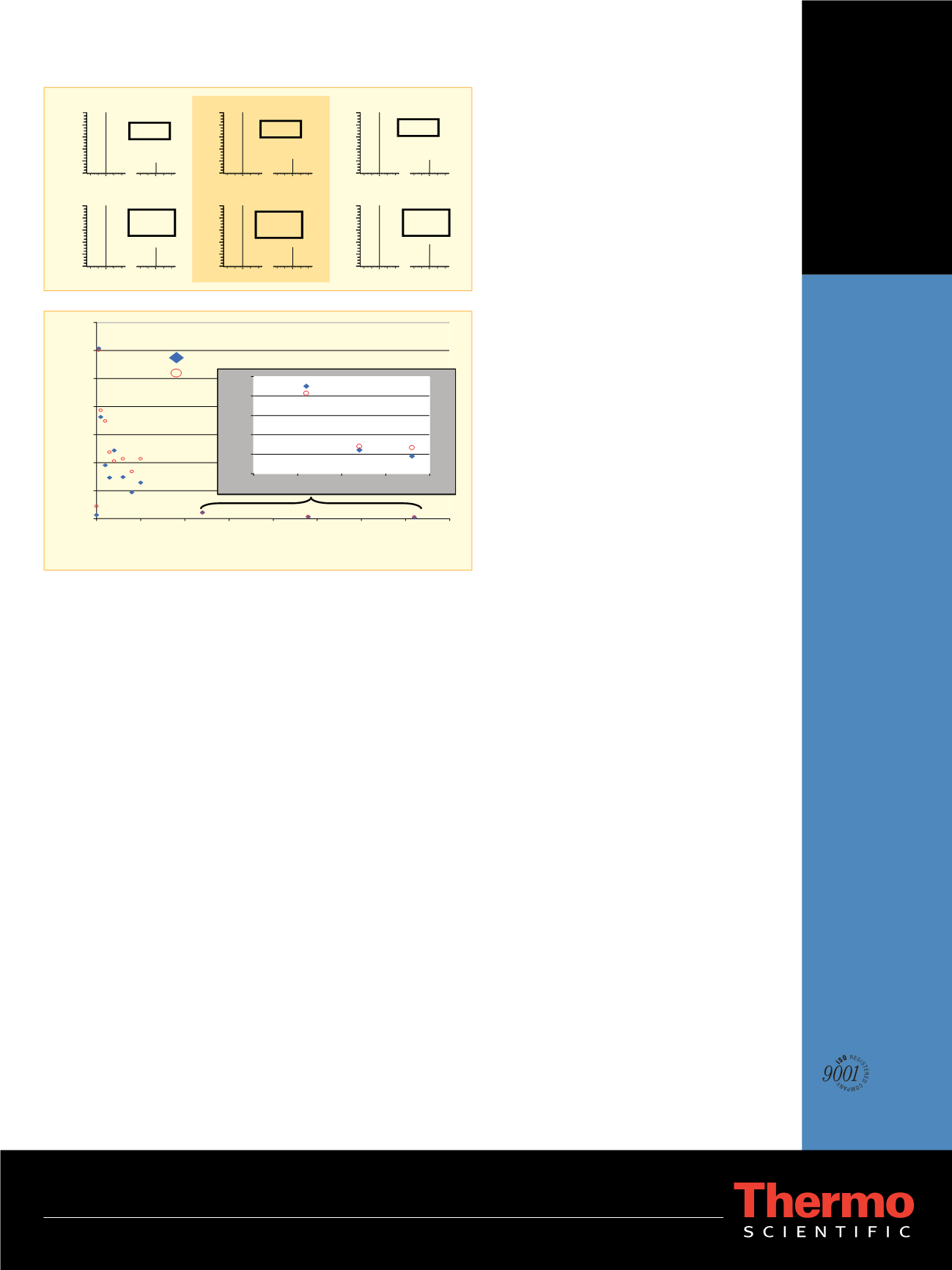

AN62502_E 12/07S
Part of Thermo Fisher Scientific
Legal Notices
©2007 Thermo Fisher Scientific Inc. All rights reserved. All trademarks are the property of Thermo Fisher Scientific Inc. and its subsidiaries. This information
is presented as an example of the capabilities of Thermo Fisher Scientific Inc. products. It is not intended to encourage use of these products in any manners
that might infringe the intellectual property rights of others. Specifications, terms and pricing are subject to change. Not all products are available in all
countries. Please consult your local sales representative for details.
View additional Thermo Scientific LC/MS application notes at:
www.thermo.com/appnotesConclusions
The approach presented here provides a sensitive and
selective method for preparing and analyzing horse plasma
for the presence of rhEPO or DPO. The advantages of this
method include the ability to use up to six diagnostic
peptides to confirm or refute the presence of either illegal
protein-based drug.
The use of stable-isotope labeled analogues provides
further means of confirming the presence of diagnostic
peptides based on chromatographic retention times and
ion ratios.
The sensitivity demonstrated enabled detection up to
72 hours following the last administration of rhEPO,
increasing the confidence that the described method is
useful in the racing industry to maintain a level field of
competition.
Of particular interest is the measured sensitivity that
was achieved using microspray, increasing the analysis
time while simplifying the experimental method and thus,
enabling more laboratories the option of employing
rhEPO/DPO screening.
References
1
Guan, F., Uboh, C., E., Soma, L. R., Birks, E., Li, X., Chen, Y., Mbuy, G.,
LC-MS/MS Method in the Confirmation of Recombinant Human
Erythropoietin and Darbepoietin-alpha in Equine Plasma, accepted by
Analytical Chemistry (see WP 245 for additional applications).
2
Krantz, S. B. Erythorpoietin,
Blood
,
1991
, 77, 419-434.
3
Egrie, J. C., Browne, J. K., Development and Characterization of Novel
Erythropoiesis Stimulating Protein (NESP),
British Journal of Cancer
,
2001
, 84, 3-10.
4
Piercy, R. J., Swardson, C. J., Hinchcliff, K. W., Erythroid Hypoplasia and
Anemia Following Administration of Recombinant Human Erythropoietin
to Two Horses,
Journal of the American Veterinary Medical Association
,
1998
, 212, 244-247.
Acknowledgements
We would like to thank Amgen, Inc (Thousand Oaks, CA) for kindly
donating the rhEPO and DPO standards used in this study, and the PA
Racing Commissions for financial support.
0
1
2
3
4
5
6
7
T4 and T6
ng/ mL of horse plasma
Time Between Administration and Plasma Collection
(hrs)
8,000 International Units Administered (200 IU = 1 ug)
T4
T6
0
0.05
0.1
0.15
0.2
0.25
0.06 ng/mL
0.23 ng/mL
0
10
20
30
40
50
60
70
80
0
20
40
60
80
Figure 7: Calculated rhEPO levels in
extracted horse plasma as a function of
time delay between administration and
sample collection. The calculated levels
were based on the area ratios of T
4
and
T
6
targeted rhEPO peptides and the
labeled internal standards.
460.300
m/z
573.400
m/z
0
20
40
60
80
100
RelativeAbundance
460.30
573.40
460.300
m/z
573.400
m/z
0
20
40
60
80
100
RelativeAbundance
460.30
573.40
460.300
m/z
573.400
m/z
0
20
40
60
80
100
RelativeAbundance
460.30
573.40
467.300
m/z
580.400
m/z
0
20
40
60
80
100
RelativeAbundance
467.30
580.40
467.300
m/z
580.400
m/z
0
20
60
80
100
RelativeAbundance
40
467.30
580.40
467.300
m/z
580.400
m/z
0
20
40
60
80
100
RelativeAbundance
467.30
580.40
Labeled
rhEPO
10 hrs
72 hrs
0.5 hrs
rhEPO
rhEPO
rhEPO
Labeled
rhEPO
Labeled
rhEPO
Figure 6: Comparative ion abundance
ratios for the T
4
peptide at three
different time points for plasma
collection. The top row is the measured
ion abundance for the unlabeled peptide
and the bottom row is the response from
the labeled peptide.
In addition to these
offices, Thermo Fisher
Scientific maintains
a network of represen-
tative organizations
throughout the world.
Africa
+43 1 333 5034 127
Australia
+61 2 8844 9500
Austria
+43 1 333 50340
Belgium
+32 2 482 30 30
Canada
+1 800 530 8447
China
+86 10 5850 3588
Denmark
+45 70 23 62 60
Europe-Other
+43 1 333 5034 127
France
+33 1 60 92 48 00
Germany
+49 6103 408 1014
India
+91 22 6742 9434
Italy
+39 02 950 591
Japan
+81 45 453 9100
Latin America
+1 608 276 5659
Middle East
+43 1 333 5034 127
Netherlands
+31 76 587 98 88
South Africa
+27 11 570 1840
Spain
+34 914 845 965
Sweden/Norway/
Finland
+46 8 556 468 00
Switzerland
+41 61 48784 00
UK
+44 1442 233555
USA
+1 800 532 4752
www.thermo.comThermo Fisher Scientific,
San Jose, CA USA is ISO Certified.



















